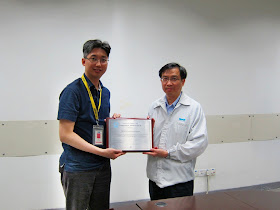Seminar on Toys Product Testing – Latest Development and Business Opportunities was organized by Hong Kong Council for Testing and Certification (HKCTC), Hong Kong Toys Council (HKTC), Hong Kong Accreditation Service (HKAS) and Vocational Training Council (VTC) on 28 April 2011. Hong Kong Society for Quality (HKSQ) was one of supporting organizations. The seminar aimed to highlight the latest development in toys product testing as well as the trend in safety and standards. The content of seminar was summarized as follows.
In the beginning of the seminar, Mr. Bernie Ting (Chairman of Hong Kong Toys Council / Member of HKCTC) gave a welcoming remark. He said “No testing! No toys!”, indicating how importance of testing in toys product. Then he appreciated VTC and Universities training product testing talents.

The first speaker was Dr. Vincent Tam (Exco member of Hong Kong Toys Council / Director of Systems & Compliance, Jetta Company Ltd.) and his presentation topic was “Dealing with the Chemical Challenge”
Dr. Vincent Tam briefed the background of Hong Kong Toys Council and then introduced different toys safety requirement such as CE, REACH, etc.
Then Dr. Tam mentioned what challenges toys manufacturers faced to. It was not only testing report, but also included BOM, BOS, MSDS, Risk Assessment, etc. The whole supply chain was involved.
He said that Hong Kong Toys Council proposed two solutions. They were:
i) Material Management System (MMS)
ii) Chemical Management Database (CMD)
Finally, Dr. Tam explained the vision of MMS and CMD to us.
The second speaker was Mr. Ben Lau (Director of Toys, Premiums and Juvenile Products, Bureau Veritas Hong Kong Limited) and his topic entitled “CPSIA – Reasonable Testing Program Requirements”.
Firstly, Mr. Lau introduced the history of the Consumer Product Safety Improvement Act (CPSIA). The proposed rule “16 CFR 1107 – Testing and Labeling pertaining to Product Certification” was effective on May 2010. The final rule was coming soon (estimated to be Jul / Aug, 2011).
Then Mr. Lau briefed the Reasonable Testing Program (RTP). It would be mandatory for manufacturers to have in place a RTP for all products that require certification under CPSIA. RTP was for Non-Children’s Products. Children’s Product Testing Program (CPTP) was for Children’s Products. The following diagram showed RTP and CPTP.
Elements of a RTP included “Product specification”, “Certificate testing”, “Product testing plan”, “Remedial action plan” and “Record keeping”.
Elements of a CPTP included “Certificate testing (3rd party testing required)”, “Periodic testing plan”, “Random sampling”, Material change tracking”, “Records of undue influence”, “Remedial action plan” and “Record keeping”.
The comparison table was showed below.
Finally, Mr. Lau presented the schedule of RTP implementation for user reference.
Ms. Christina Chan (Technical Manager, Chemical Department, TUV SUD) was the third speaker and her speech named “Chemical Testing on New EU Directive”.
Ms. Chan introduced the new Toy Safety Directive 2009/48/EC which aimed to ensure a high level of protection of children (under 14 yr) against risk due to chemical substances in toys and use of dangerous substance such as Carcinogens, Mutagens and Reproductive Toxins (CMRs), allergenic substances, etc.
The safety requirements included:
i) Physical and Mechanical Properties
ii) Flammability
iii) Chemical Properties
iv) Electrical Properties
v) Hygiene
vi) Radioactivity
Ms. Chan focused on discussing “Chemical Properties”. The following diagram showed the different requirement between new (2009/48/EC) and old (88/378/EEC) toy safety directive in chemical requirement.
Then Ms. Chan compared the main different in the migration of certain element of 2009/48/EC.
Since there was no standard test method specific for new toy safety directive on chemical requirement, the suggested testing methods were showed below.
The time line for new toy directive 2009/48/EC was listed for our reference.
At the end, Ms. Chan summarized different chemicals legislations.
Mr. William Wong (Deputy Directory, Toys and Juvenile Products, SGS HK Ltd.) and his topic entitled “Issues on Safety Test and Testing Equipment”.
Mr. Wong briefed some accidents because of children behavior. One example was a 19-month-old boy and a 2-year-old boy, suffocated when oversized, plastic toy nails sold with the tool bench toys became forcefully lodged in their throats.
Under the new requirement, Mr. Wong explained the risk assessment which included chemical, physical, mechanical, electrical, flammability, hygiene and radioactivity hazards.
The following table showed some examples for analysis of new elements in the toys directive.
After that Mr. Wong introduced the EN 71-1:2011 (DRAFT) standard and its new requirement such as cords.
Yo-yo ball elongation was another new requirement. Then he also mentioned the DRAFT EN 62115 A2 & A3 standard.
The last speaker was Dr. Eric Sze (Senior Accreditation Officer, HKAS) and his topic named “How Accreditation Can Help You”.
Dr. Sze briefed the history of HKAS and then introduced their key job which was to ensure the competence of laboratories, inspection bodies and certification bodies.
The following diagram described three schemes in HKAS and what standard they followed.
After that Dr. Sze explained the Mutual Recognition Arrangement (MRA) and HKAS had been recognized by different countries and economic areas. Finally, Dr. Sze demonstrated three examples of accreditation required for toys:
i) US Consumer Products Safety Improvement Act (CPSIA) – accreditation is required to register as the 3rd party laboratory;
ii) China Compulsory Certification (CCC) – accredited laboratory by HKAS is required to be approved for conduct CCC testing under CEPA VII; and
iii) Japan Food Sanitation Law.
Dr. Lawrence Chan (Deputy Executive Director, Vocational Training Council) gave a closing remark. He introduced many different courses which provided specific for product testing and certification and posted in VTC new website.
Group photo
Reference:

















































